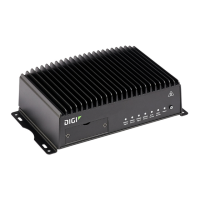Interfaces Cellular interfaces
Digi TransPort WR Routers User Guide
26
Cellular interfaces
Depending on the model, Digi TransPort devices can support one or two cellular modules, and each
module supports two SIMs. This means that a TransPort device can have either two or four cellular
interfaces:
n cellular1-sim1
n cellular1-sim2
n cellular2-sim1 (only on models with two cellular modules)
n cellular2-sim2 (only on models with two cellular modules)
Each cellular module can have only one interface up at any one time (for example, cellular module 1
can have either SIM1 or SIM2 up at one time). Cellular interface priority is determined by how the
cellular interfaces are assigned to the WAN interface.
Typically, an administrator would configure cellular1-sim1 as the primary cellular interface and
cellular1-sim2 as the backup cellular interface. In this way, if the TransPort device cannot connect to
the network using cellular1-sim1, it automatically fails over to cellular1-sim2. TransPort devices
automatically use the correct cellular module firmware for each carrier when switching SIMs.
A device that has two cellular modules can have two cellular interfaces up at one time—one for each
module. Typically, an administrator would route traffic to different destinations over a specific cellular
interface.
For more information on WAN interfaces and their configuration, see Wide Area Networks (WANs).
Configure cellular interfaces
Required configuration items
n Access Point Name (APN): The APN is specific to your cellular service.
n APN username and password: Depending on your cellular service, you may need to configure
an APN username and password. This information is provided by your cellular provider.
n WAN assignment: Once configured, if the cellular interface is not already assigned to a WAN
interface, assign it to a WAN interface. For more information, see Wide Area Networks (WANs).
Additional configuration items
See Interfaces—cellular page for a complete list of configuration options.

